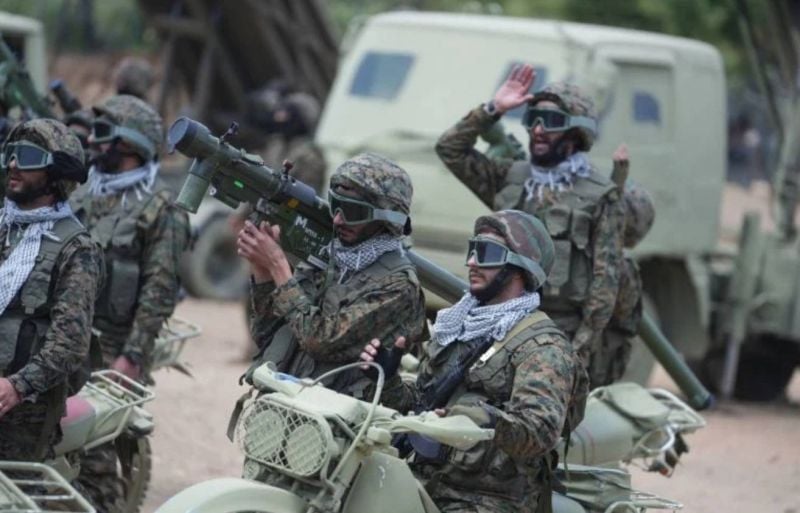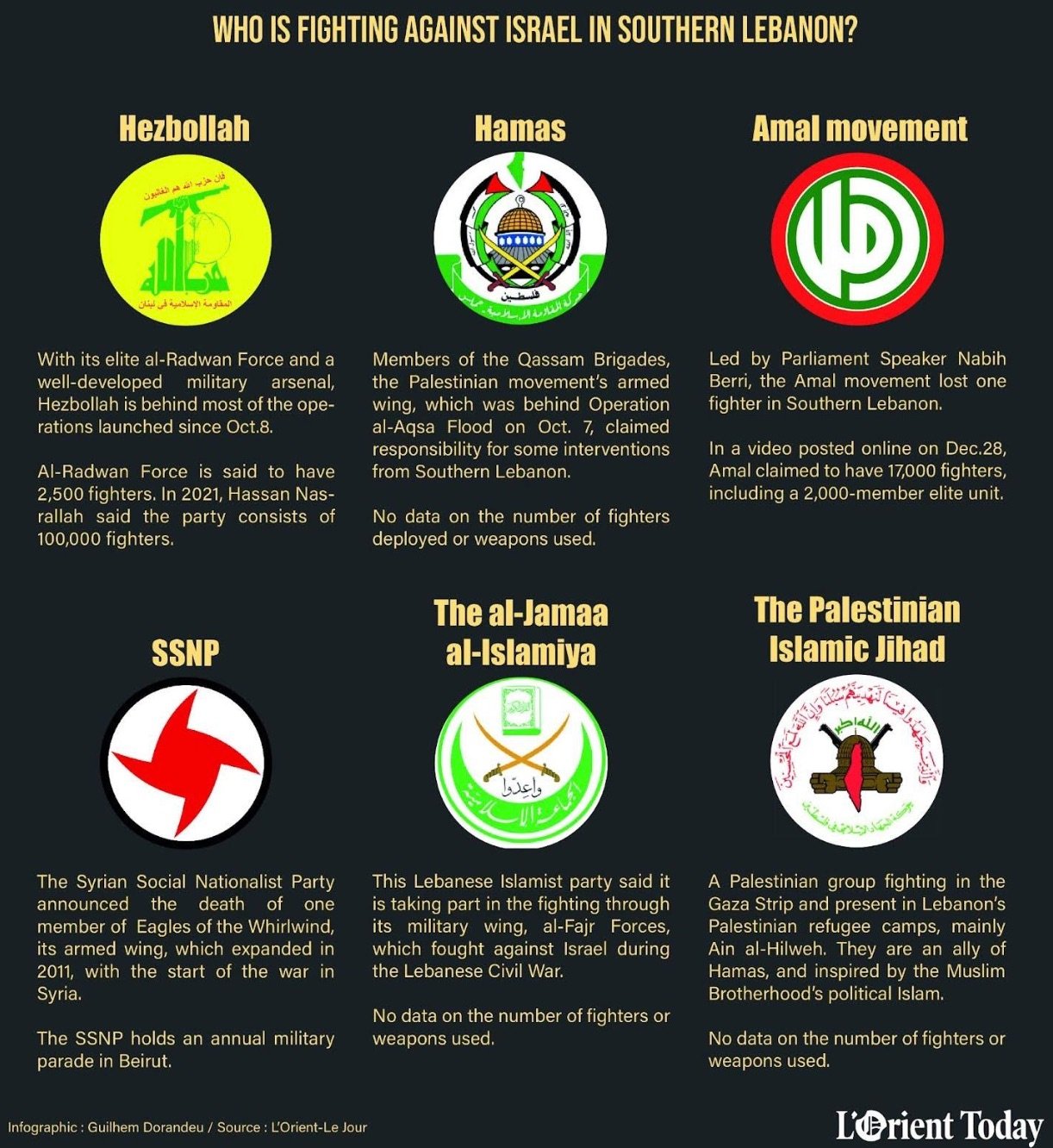
Hezbollah fighters during a military demonstration in Aaramta, South Lebanon. May 2023. (Credit: Mohammad Yassine/L'Orient-Le Jour)
Since the start of the war in Gaza, there has been no doubt that Hezbollah would carry out attacks from southern Lebanon. The party, which has made its “resistance” against Israel its main battlehorse, is the only group to have officially kept its weapons after the Lebanese Civil War (1975-1990).
This commitment is part of the “unity of the fronts,” which implies close coordination between members of the “resistance axis” in their fight against Israel.
Beyond the expected presence of Hezbollah, other belligerents are involved on the front in South Lebanon, which is now open to all possibilities.
Besides Hezbollah, several Lebanese and Palestinian armed parties and groups have claimed attacks since Oct. 8, causing concerns across the country.
In recent weeks, this “support front” for Gaza has included militants from Parliament Speaker Nabih Berri’s Amal movement, members of al-Fajr Forces, the military wing of the al-Jamaa al-Islamiya in Lebanon, and fighters of the Eagles of the Whirlwind, the armed wing of the Syrian Social Nationalist Party (SSNP). This is in addition to the presence of Hamas’ Qassam Brigades and the al-Quds Brigades of the Palestinian Islamic Jihad (PIJ).

Sunni support?
Why are there so many armed factions in southern Lebanon, when Hezbollah has until now reserved the exclusive right to intervene at the border, apart from the occasional rocket fired with its consent?
Imad Salameh, professor of international relations at the Lebanese American University (LAU), believes that Hezbollah is trying to win Sunni support by allying itself with Palestinian factions or the al-Jamaa al-Islamiya.
“Hezbollah wants to show that it is close to the Sunnis and that its war against Israel serves to defend the Palestinian Sunnis. It is trying, along with Iran, to show that it is not opposed to them. In this way, it will make it more difficult for Arab countries, particularly Saudi Arabia, to normalize relations with the Jewish state,” he said.
This interpretation was refuted by a Hamas official in Beirut, who explained to L’Orient-Le Jour that “the front (in South Lebanon) is open, and those who have the means to fight do so, without dragging Lebanon into a wider war.”
“It is normal for other groups to join the fight (alongside Hezbollah). South Lebanon is not hermetic. These groups don’t need to coordinate with Hezbollah,” said Kassem Kassir, a journalist close to Hezbollah.
He added, “Hezbollah doesn’t need a Sunni support, as long as it is in the exercise of its responsibilities.”
L’Orient-Le Jour tried to speak to a senior Hezbollah official, but he was not available for comment.
Commenting on the presence of Amal and the SSNP, Salameh said that “the more Hezbollah widens the front line and diversifies the participants to it, the more it legitimizes the presence of weapons in the service of the resistance against Israel.”
Speaking to The Independent in October, Bassam Hammoud, deputy head of al-Jamaa al-Islamiya’s political bureau, justified his party’s armed presence, saying that the ministerial statements of the successive cabinets in Lebanon, which recognize Hezbollah’s “resistance” against Israel have enshrined the right of the Lebanese people to resist. This applies to al-Jamaa al-Islamiya and to all the factions resisting in southern Lebanon, he said.
‘Symbolic’ participation
In terms of the balance of power on the ground, there is no doubt that Hezbollah has the most resources. With a well-developed military arsenal and some 100,000 fighters, according to Hassan Nasrallah in 2021, Hezbollah leads the vast majority of operations from the south. This is especially thanks to its elite al-Radwan Force, which the Israeli media estimated at 2,500 men.
Hezbollah is by far the one that has lost the most fighters since Oct. 8. According to L’Orient-Le Jour’s count, at least 159 Hezbollah members died in the recent clashes with Israel. This includes Wissam Tawil, a senior commander within the al-Radwan Force, who was killed last Monday.
The PIJ lost 10 men; Hamas lost 14, including two Turkish Islamists who had come to fight in southern Lebanon; the SSNP lost one fighter. The al-Jamaa al-Islamiya, for its part, said two of its members were killed in the attack that claimed the life of Hamas’ second in command, Saleh al-Arouri, in Beirut’s southern suburbs. The Lebanese army, which has not intervened so far in southern Lebanon, lost a soldier in an Israeli attack.
According to estimates provided by Salameh, Hezbollah has deployed 20,000 men on the ground, including 5,000 in Syria and 15,000 in Lebanon, between the South and the Bekaa Valley. He added that 2,000 militants in Lebanon are stationed within a seven-kilometer radius of the border.
The Amal movement, which is usually discreet about its military activities, claims to have sophisticated weapons and 17,000 fighters, including a 2,000-member elite unit, in a video posted online on Dec.28. However, its participation in the fighting seems to be limited, with the movement declaring the death of one person within its ranks.
Speaking to L’Orient-Le Jour, MP Hani Qobeisi (Amal/Nabatieh) denied any organized military presence within his party, despite the release of this video, in which he spoke.
“We have no official [military] presence. These are young people from the villages in the area who are defending themselves. It’s a popular movement, not an organized group,” he said.
As for the rest of the belligerents, “there is no official information on their weaponry or the number of fighters deployed,” said retired general Khalil Helou.
“Apart from Hezbollah and Amal, which have bases in southern Lebanon, the participation of the other armed groups is above all symbolic,” he said.
Salameh estimated that there are around 10,000 Hamas fighters in Lebanon.
“Some factions claimed responsibility for a few attacks in southern Lebanon [at the start of the war in Gaza], then sort of disappeared,” said journalist Bachir Moustapha. “Most of them don’t have the means to fight a full-scale war, as is now the case on the ground.”
Facing this situation, which risks further ruining Lebanon, a “regional solution” is key, Salameh said.
“As long as the Iranian nuclear file and the sanctions imposed on Tehran have not been resolved, the groups that rotate in the orbit of Iran will continue to fight. But if no solution is found, Lebanon risks being caught up in a regional battle with no way out,” he warned.
This article was originally published in French in L'Orient-Le Jour. Translation by Joelle El Khoury.